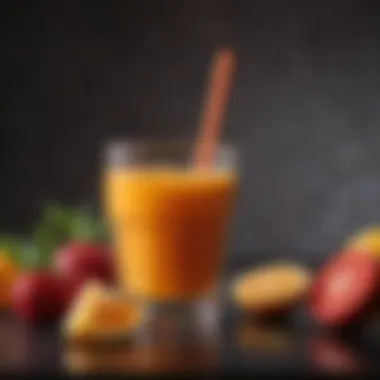The Ultimate Guide to Juicing: Techniques and Benefits


Intro
Juicing has gained popularity as a method to enhance diet and health. For many, it represents not just a trend but a lifestyle shift towards better nutrition. It offers an array of benefits, including increased vitamin intake and improved digestion. However, not all juicing methods yield the same results. This article will explore various techniques, equipment, and considerations surrounding juicing, ultimately assisting individuals make informed choices.
Recipe Overview
Recipe Name
Nutrient-Rich Green Juice
Description of the Dish
This green juice combines leafy greens and fruits to create a refreshing drink. It packs essential vitamins and minerals in a single serving. The combination of spinach, cucumber, and apple provides a balance of flavors, making it easy to consume and beneficial to health.
Ingredients
- 2 cups of fresh spinach
- 1 medium cucumber
- 1 medium green apple
- 1/2 lemon (juiced)
- 1 cup of water
- Optional: ginger for an extra kick
Special Notes on Ingredients
- Substitutions: Kale can be used instead of spinach for a richer flavor. Cabbage is also an alternative if specific leafy greens are unavailable.
- Regional Variants: Some regions prefer adding more tropical fruits like pineapple to enhance sweetness. Adjust ingredients based on local availability and personal preference.
"Juicing can unlock the potential of fruits and vegetables, converting them into an easily digestible format, packed with nutrients."
This section has outlined the basics of crafting a refreshing green juice, paired with ingredient suggestions. The next paragraphs will navigate through the best methods of juicing, aimed at optimizing flavor and nutrients.
Preface to Juicing
Juicing is not just a culinary trend; it is a pathway to better health and well-being. The act of extracting juice from fruits and vegetables allows individuals to harness the concentrated nutritional value of these foods. By focusing on juicing, this article aims to examine the various methods available, the importance of proper ingredient selection, and the equipment needed to elevate the process. The benefits of juicing extend beyond mere nutrition. It offers a convenient way to increase daily intake of fruits and vegetables while exploring diverse and exciting flavors.
Understanding Juicing
Juicing refers to the extraction of liquid from plant foods. This process separates the juice from the pulp, which may include fiber and other components. Juicing can be performed using various methods, each producing distinct qualities in the final product. For many, the primary benefit is the quick and efficient consumption of vitamins and minerals that are essential for health. However, it is not a replacement for whole foods but rather a complementary part of a balanced diet. Understanding the nuances of juicing can empower individuals to make informed choices that cater to their nutritional needs.
Historical Context of Juicing
The history of juicing is rooted in ancient practices. In many cultures, the extraction of juice from fruits and vegetables has served medicinal purposes. The modern juicing movement gained momentum in the 20th century, particularly with the work of health enthusiasts promoting raw food diets and natural health remedies. Notably, the publication of books on juicing garnered interest in the idea of using juice for detoxification and overall health. Over the years, juicing has become more accessible due to advancements in technology, allowing for various juicing techniques. Understanding this historical context helps to appreciate the role juicing plays in contemporary health habits.
"Juicing can serve as a bridge between whole foods and easier consumption, facilitating better dietary habits."
Juicing Methods Overview
Understanding the various methods of juicing is crucial for anyone interested in extracting the maximum nutritional value from their fruits and vegetables. Each technique not only influences the juice's yield and flavor but also preserves different nutrients. Knowing the specifics about these methods allows individuals to tailor their juicing experience according to their health goals and preferences.
Cold Press Juicing
Cold press juicing involves crushing and then pressing fruits and vegetables to extract juice. This method operates at a low temperature, effectively minimizing oxidation. The primary advantage is that it helps retain vitamins, minerals, and enzymes, which are sensitive to heat. Many health enthusiasts prefer cold pressing for these reasons.
Some notable features of cold press juicing include:
- Higher Nutrient Retention: Since the process doesn't involve heat, it conserves more nutrients compared to other methods.
- Longer Shelf Life: Juices made through cold pressing generally last longer in the refrigerator due to less aeration.
- Improved Flavor Profile: Cold pressing extracts juice with vibrant flavors, providing a fresher taste.
Nevertheless, the equipment can be quite expensive. Users also must be patient as the process is usually slower than other methods.
Centrifugal Juicing
Centrifugal juicing utilizes a fast-spinning blade to segregate juice from the pulp. This method is popular for its speed and ease of use. The motorized action quickly processes fruits and vegetables, yielding a substantial amount of juice in a short time.
Key points about centrifugal juicing include:
- Speed: This method can produce juice rapidly, making it suitable for busy lifestyles.
- Affordability: Centrifugal juicers are often more economical than their cold press counterparts.
- Versatility: They can handle most fruits and vegetables but may struggle with leafy greens.
On the downside, this method tends to produce more foam and pulp and can lose some nutrients due to heat generated during the spinning process.


Masticating Juicing
Masticating juicers, often referred to as slow juicers, function by slowly grinding and squeezing the produce. This method operates at low speeds and prevents heat buildup, thus preserving nutrients effectively. It is considered to be a hybrid between cold pressing and centrifugal juicing.
Features of masticating juicing are:
- Efficient Extraction: They extract juice effectively, making them suitable for a range of ingredients, including leafy greens.
- Nutrient Preservation: Similar to cold press, they maintain the integrity of vitamins and minerals.
- Ability to Process Various Ingredients: Masticating juicers perform well with both soft and hard fruits and vegetables.
The downside can be the time it takes for juicing, which might not appeal to everyone.
Blending vs. Juicing
This is often a point of confusion for many individuals. While both methods aim to provide a liquid form of fruits and vegetables, the results are quite different. Blending incorporates the whole fruit, resulting in thick smoothies, whereas juicing extracts only the liquid, discarding the pulp.
Consider the following differences:
- Nutritional Differences: Juicing removes fiber, which may lead to quicker absorption of sugars, while blending retains the fiber, aiding digestion.
- Texture and Consistency: Juiced beverages are more liquid and can be easier to drink quickly, while smoothies are heartier and can be a meal replacement.
- Preparation Time: Juicing often requires more preparation and cleanup, particularly with certain juicers, while blenders might be less demanding.
Choosing the Right Equipment
Selecting the right equipment for juicing is crucial for achieving optimal results. The various types and styles of juicers directly impact the quality and nutritional value of the juice. The right tools of the trade can make the juicing process more efficient, enjoyable, and rewarding. Not only does the quality of the juicer matter, but also the accessories that enhance the juicing experience.
When choosing equipment, it is essential to consider your personal juicing needs and goals. Do you plan to juice daily? Will you be preparing juices for the entire family or just for yourself? Each of these factors influences the type of juicer and accessories you will need. Additionally, your budget plays a significant role, as juicers can vary widely in price based on functionality and brand reputation.
Evaluating Juicers
The evaluation of juicers should focus on several key aspects including efficiency, ease of cleanup, and overall durability. Cold press juicers are popular due to their ability to extract juice without heat, preserving nutrients. However, they may be more expensive and require more preparation time. Centrifugal juicers, on the other hand, are typically more affordable and faster. However, they may not extract as much juice or retain the same nutrient levels, as heat is generated during the process. For those who aim for higher nutrient retention, masticating juicers may be the ideal option. They slowly crush fruits and vegetables, yielding more juice while minimizing oxidation and preserving vital nutrients.
It is also practical to check for warranties and customer reviews to gauge reliability and satisfaction. Notice how easy it is to assemble and disassemble the juicer. Simple constructions lead to easier cleaning and less frustration.
Essential Accessories
Having the right accessories is equally important. These can enhance the juicing process and improve the juice's storage lifespan. Commonly needed accessories include:
- Cutting Boards: A sturdy cutting board helps prepare your ingredients without causing damage to countertops.
- Knives: Good-quality knives make it easier to chop fruits and vegetables into manageable pieces.
- Strainers or Nut Milk Bags: These are useful for filtering out pulp if a smoother juice is desired.
- Storage Containers: Glass jars or BPA-free bottles are excellent for storing fresh juice, ensuring they remain fresh longer.
- Ice Cube Trays: Handy for freezing juice in portions for later use.
"The right juicer and accessories can transform your juicing routine from a chore to a lifestyle choice, maximizing benefits for health and enjoyment."
Each accessory serves a purpose that complements the juicing experience. Investing in quality equipment and accessories pays off by enhancing the flavors and textures of your juices, while also simplifying preparation and cleanup.
Ingredient Selection
Ingredient selection is fundamental to successful juicing. The quality and types of ingredients you choose influence not only the flavor profile of your juice but also its nutritional content. Understanding the unique benefits of each ingredient allows you to craft juices that meet your health goals while also being palatable. Factors such as seasonal availability, sourcing practices, and personal dietary needs should be considered when selecting ingredients.
Fruits: Optimal Choices
Fruits are a vital component of most juice recipes. They provide natural sweetness, a variety of flavors, and essential vitamins. When choosing fruits for juicing, consider the following:
- Seasonality: Selecting seasonal fruits ensures freshness and often better taste. Fruits like apples, oranges, and berries are great options, as they are typically available year-round.
- Nutritional Content: Some fruits are richer in vitamins than others. For example, spinach can be added for its high iron and vitamin K content while berries offer antioxidants.
- Flavor Profiles: Combining different fruits can create a balanced flavor. Citrus fruits, such as grapefruit and lemon, add acidity, complementing sweeter fruits like mango and banana.
Popular choices for juicing include:
- Apples
- Oranges
- Pineapples
- Strawberries
- Watermelon
Each fruit brings its benefits, so mixing and matching can enhance both the taste and the nutritional value of your juice.
Vegetables: Best Varieties
Vegetables provide essential nutrients that fruits may lack. Dark leafy greens and root vegetables can greatly improve the health benefits of juice. When selecting vegetables:
- Leafy Greens: Spinach, kale, and Swiss chard are excellent for adding fiber, vitamins A, C, and K.
- Root Vegetables: Carrots are a popular choice for their sweetness and rich beta-carotene content. Beets are another robust addition, known to support blood health.
- Cruciferous Vegetables: Vegetables like celery and cucumber add hydration and depth to juices. Their high water content can contribute to overall hydration.
Common vegetable choices for juicing include:


- Kale
- Spinach
- Carrots
- Beets
- Cucumber
This mix adds not just variety but also multiple health benefits that can enhance well-being.
Additives: Boosting Nutritional Value
In addition to fruits and vegetables, additives can significantly enhance the nutritional value of your juice. These can include:
- Herbs and Spices: Fresh herbs like mint or basil can add flavor and antioxidants. Ginger and turmeric are known for their anti-inflammatory properties and can spice up flavors.
- Superfoods: Chia seeds and flaxseeds are rich in omega-3 fatty acids. Adding these can increase the nutrient density of your drinks.
- Supplements: Protein powders or greens powders might be included for those looking to increase energy or muscle recovery.
When carefully selected, these additives not only improve the taste but also empower the juice with additional health benefits, making each drink as nutritious as it is flavorful.
Juicing Process Explained
Understanding the juicing process is essential for anyone looking to maximize the health benefits of fresh juices. This step involves not only selecting the right ingredients, but also knowing how to prepare, extract, and store these juices effectively. The process can be nuanced, with specific techniques and considerations that influence both the taste and nutritional value of the final product. Knowing these nuances enhances the juicing experience while ensuring that the nutrients you aim to obtain are kept intact.
Preparing Ingredients
Preparation is a crucial aspect of juicing that directly impacts the efficiency and quality of the juice. Ingredients should be washed thoroughly to remove dirt or pesticides. This ensures that the juice is both safe and clean. Depending on the type of juicer used, cutting the fruits and vegetables into smaller pieces may be necessary. For instance, centrifugal juicers can handle larger pieces, whereas masticating juicers work best with finely chopped ingredients.
Additionally, it's beneficial to select fresh, organic produce when possible. Fresh ingredients have higher nutrient content and better flavor.
To prepare ingredients effectively:
- Wash fruits and vegetables well to remove any residues.
- Remove seeds and pits, as they can affect juicing efficiency.
- Cut ingredients based on your juicer’s requirements.
- Consider combining flavors that complement each other for a more balanced juice.
Juicing Techniques
Different juicing techniques can bring out distinct flavors and textures in juices. Knowing which technique to use can enhance the overall juicing experience. The primary methods include cold press, centrifugal, and masticating techniques.
Cold press juicing retains more nutrients and enzymes, making it a preferred choice for many health enthusiasts. This method uses hydraulic pressure to extract juice without exposing it to heat. In contrast, centrifugal juicers operate at high speed, which may result in some nutrient loss due to heat generation. Masticating juicers, on the other hand, crush the ingredients slowly, preserving more nutrients similar to the cold press method.
"The method of juicing significantly affects the nutrient retention and taste quality. Choose wisely based on your needs."
Storage of Juices
Once the juice is prepared, storage becomes a vital consideration. Fresh juice is best consumed immediately due to its perishable quality, but it's often impractical in a busy lifestyle. If you need to store juice for later use, proper methods can prolong its freshness.
Here are essential tips for storing juices effectively:
- Use airtight containers: Glass jars or BPA-free plastic containers are ideal to limit exposure to air.
- Refrigerate immediately: Juice should be stored in the refrigerator right after extraction, ideally in the coldest section.
- Consume within 24 hours: For maximum freshness, try to drink your juice within a day to benefit from its full nutritional profile.
- Label your containers: Note down the date and ingredients to keep track of freshness.
By understanding the juicing process, including how to prepare, extract, and store juices, individuals can significantly enhance their juicing experience. Knowledge in these areas empowers one to make informed decisions and enjoy the full benefits that fresh juices offer.
Health Benefits of Juicing
The realm of juicing extends far beyond the simple pleasure of sipping freshly extracted liquid from fruits and vegetables. The health benefits are both immediate and long-term, offering a substantial advantage to those who integrate it into their diets. Understanding these benefits is key to making informed choices regarding how we consume food and drink. Juicing serves as a practical approach to enhance one's nutritional intake, particularly for individuals striving for better health.
Nutritional Insights
Juicing provides a concentrated source of vitamins, minerals, and phytonutrients. These components play essential roles in various bodily functions. For example, the vitamin C found in citrus fruits can boost the immune system, while minerals like potassium are crucial for maintaining healthy nerve function. Also, phytonutrients, which are natural compounds in plants, have been studied for their antioxidant properties. They can help in combating oxidative stress, thus potentially reducing the risk of chronic diseases.
It's important to consider the variety of ingredients in juices. By incorporating a range of fruits and vegetables, individuals can ensure they receive a broad spectrum of these beneficial nutrients. For those adhering to specific dietary restrictions, juicing offers a flexible way to tailor nutrition according to personal health goals. However, it should be noted that some nutrients are lost in the juicing process. For example, dietary fiber, crucial for digestive health, is mostly discarded when pressing or centrifuging.
Impact on Digestion
The relationship between juicing and digestion is noteworthy. Juices can provide easily digestible nutrients, which makes them suitable for individuals with digestive issues. For instance, juice from cucumber, carrot, or ginger can soothe the digestive tract and can promote healthy gut flora. Additionally, hydration from juicing may aid digestion further, as water helps break down food in the stomach.
However, it is vital to pair juices with whole foods when possible, in order to benefit from the fiber content that whole fruits and vegetables offer. Too much juice without sufficient fiber can lead to digestive irregularities. Striking a balance is crucial, as it contributes positively to gut health while still offering the convenience and benefits of juicing.
Hydration Considerations
Staying hydrated is pivotal for overall health, and juicing plays a significant role in this aspect. Many fruits and vegetables have high water content, which contributes to daily hydration needs. For instance, watermelon contains about 92% water. Consuming juices derived from such produce can help maintain fluid balance in the body.


That said, one cannot solely rely on juice for hydration. Juicing should complement a balanced intake of water and other fluids. Moreover, certain juices, particularly those high in sugars, can lead to dehydration if consumed excessively. It is vital to choose juices mindfully and ensure they are part of a well-rounded diet.
"Juicing, when done right, offers a way to enhance nutrient absorption and hydration—key components for a healthy lifestyle."
Common Misconceptions
Understanding common misconceptions surrounding juicing is crucial. These misconceptions can impact people's choices and behaviors regarding their dietary habits. By addressing these misunderstandings, we hope to provide clarity to help readers make informed decisions.
Juicing vs. Whole Fruits and Vegetables
One significant debate is about the nutritional differences between juicing and consuming whole fruits and vegetables. Some people believe that juicing is a superior method for extracting nutrients. However, this is not entirely accurate. Whole fruits and vegetables contain fiber, which aids in digestion and promotes a sense of fullness. Juicing often removes much of that fiber, leading to rapid sugar absorption and potentially higher blood sugar levels.
It is important to note that while juices provide vitamins and minerals, they lack the fiber that is critical for balanced nutrition.
Another aspect to consider is that whole foods can be more satisfying. Eating an apple provides not just the nutrients but also the act of chewing, which can enhance satisfaction and signal to the body that it has consumed food. Juices may lead to overconsumption of sugars without the corresponding nutrients the whole forms provide, skewing dietary balance.
Detox Myths
Another popular misconception is the belief in detoxification through juicing. The idea that juicing can cleanse the body of toxins lacks scientific backing. The human body is equipped with organs such as the liver and kidneys, which naturally detoxify the system. They efficiently filter out harmful substances without the need for extreme dietary practices.
Juicing is often marketed as a way to flush out toxins. However, there is little evidence to support that juices can achieve this effect. Instead, a steady, healthy diet rich in fruits, vegetables, proteins, and whole grains supports the body's natural detoxification processes.
Furthermore, many detox plans involve severe calorie restriction, which can be harmful. Such practices can lead to nutrient deficiencies and can disrupt metabolic functions. It is essential for anyone considering a detox regimen to consult a healthcare professional. They can offer guidance and support based on individual health needs and goals.
Environmental Impact of Juicing
The environmental implications of juicing are significant. As more individuals adopt juicing into their diets, considering how this affects the planet becomes paramount. Various aspects of juicing can leave a footprint, including the sourcing of ingredients and the waste generated from the process. Understanding these factors will help individuals make more sustainable choices, allowing them to enjoy the benefits of juicing while minimizing their environmental impact.
Sourcing Ingredients Responsibly
When it comes to juicing, responsibly sourcing ingredients is crucial. Opting for local produce can significantly reduce transportation emissions. Seasonal fruits and vegetables tend to be fresher and have a smaller carbon footprint compared to out-of-season options that must travel long distances.
In addition, choosing organic products can benefit both personal health and the environment. Organic farming practices typically use fewer synthetic pesticides and fertilizers, promoting biodiversity and healthier ecosystems. Moreover, participating in community-supported agriculture (CSA) programs can encourage sustainable farming practices, providing fresh produce directly from local farms.
Here are some best practices for sourcing ingredients:
- Always prefer local and seasonal fruits and vegetables.
- Look for certified organic products when possible.
- Consider joining a CSA for regular access to fresh produce.
- Support farmers' markets to foster local economies.
Taking these steps not only enhances the nutritional quality of your juice but also helps support sustainable agricultural practices, making a positive impact on the environment.
Waste Management Considerations
Juicing generates waste, particularly in the form of pulp left over after extracting juice. The disposal of this pulp can become a critical environmental issue if not managed properly. Rather than simply discarding it, there are numerous ways to minimize waste and maximize the use of the whole fruit or vegetable.
Here are some suggestions for managing juicing waste effectively:
- Composting: Use the leftover pulp in your compost bin. This enriches soil and reduces landfill waste.
- Recipe Integration: Incorporate pulp into soups, smoothies, or baked goods. This not only reduces waste but also adds fiber to your meals.
- Animal Feed: If you have pets or farm animals, consider giving them the pulp. Many animals enjoy the taste and nutritional benefits.
By adopting responsible waste management practices, juicers can significantly reduce their overall environmental impact, turning potential waste into valuable resources.
In summary, the environmental impact of juicing can be managed through conscious decisions about sourcing and waste management. Making informed choices can help maintain the balance between healthy living and environmental stewardship.
Final Thoughts on Juicing
The journey through juicing reveals various methods, health benefits, and considerations. Final thoughts on juicing emphasize its significance in enhancing dietary habits and overall well-being. This practice offers not just flavor, but also a means of incorporating essential nutrients into daily routines.
Juicing acts as a bridge for individuals seeking to augment their fruit and vegetable intake. For those who may find it challenging to consume whole produce, juicing provides a more accessible way to benefit from vitamins, minerals, and antioxidants. Integrating this method into one’s lifestyle can lead to improved health metrics over time.
Integrating Juicing into Daily Life
Adopting a juicing routine begins with small changes in daily habits. Here are some practical steps to help incorporate juicing into everyday life:
- Set a Schedule: Dedicating specific days or times for juicing can help create a consistent habit. It is effective to prepare juices for the week on a single day, saving time.
- Variety of Ingredients: Explore different fruits and vegetables to prevent monotony. Try seasonal produce to maximize freshness and flavor. This approach not only keeps your juices interesting but also ensures a broad range of nutrients.
- Meal Replacement or Supplement: Juices can serve as a snack or a meal replacement. Depending on ingredients, some juices may even offer a balance of carbohydrates, proteins, and fats, contributing to a fulfilling dietary plan.
- Listen to Your Body: Individual responses to juicing can differ. Pay attention to how your body reacts to various juices and adjust accordingly. This personalization will help optimize health benefits.
Personalizing Juicing Practices
Personalization in juicing allows individuals to tailor their recipes according to preferences and health needs. Consider these aspects for customizing your juicing experience:
- Nutritional Needs: If focusing on specific health goals, adjust juice ingredients accordingly. For instance, for digestive support, consider adding ginger or lemon. For immune boosting, incorporate citrus fruits like oranges or grapefruits.
- Flavor Adjustments: Not everyone enjoys the same flavor profile. Some people may prefer sweeter juices made with apples or pears, while others might like the zestiness of kale or spinach. Experimenting with various combinations can lead to a better personal experience.
- Equipment Adaptation: Depending on your available equipment, certain juicing methods may be more suitable. Cold press juicers can retain nutrient content longer, while centrifugal juicers may be faster. Choose what fits best into your lifestyle.
- Experiment with Additives: Incorporating herbs, spices, or supplements can elevate the nutritional value of your juices. Things like turmeric, matcha, or spirulina can provide additional health benefits.
"Customizing your juicing routine enables you to explore tastes and health outcomes that align with your individual needs."







